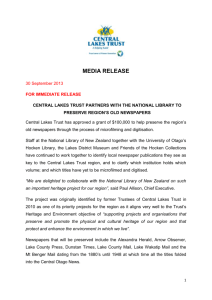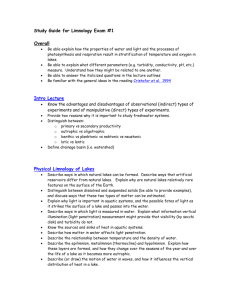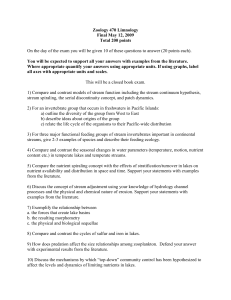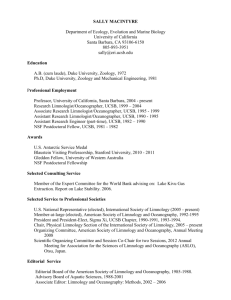LAKE CLASSIFICATION BASED ON ANNUAL CIRCULATION
advertisement
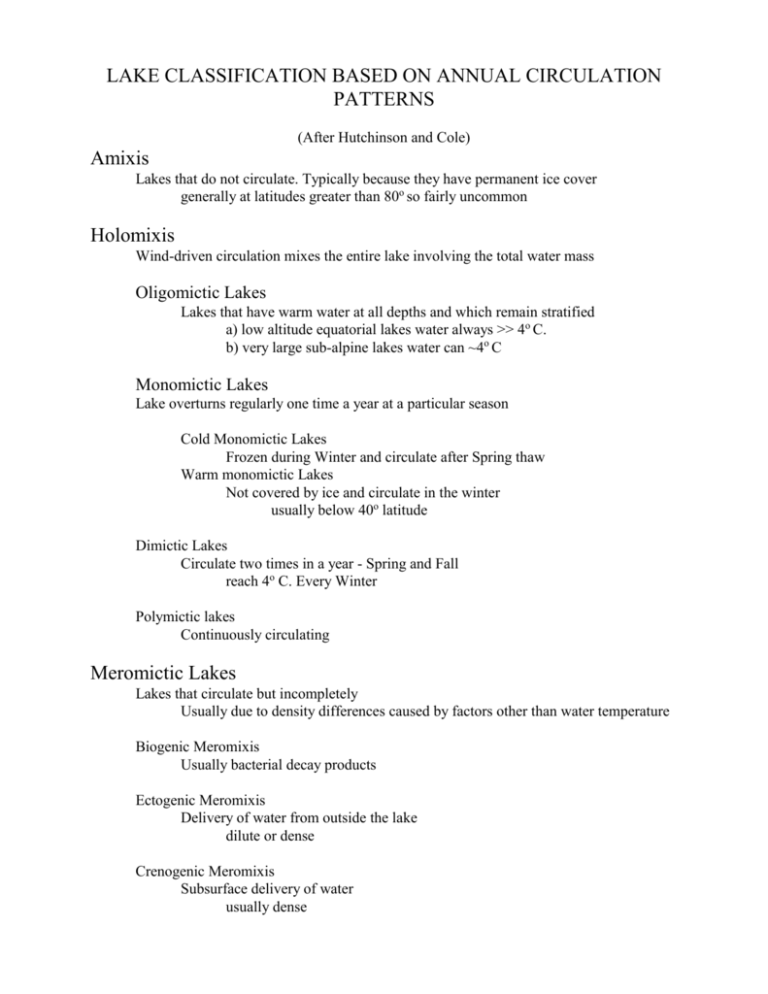
LAKE CLASSIFICATION BASED ON ANNUAL CIRCULATION PATTERNS (After Hutchinson and Cole) Amixis Lakes that do not circulate. Typically because they have permanent ice cover generally at latitudes greater than 80o so fairly uncommon Holomixis Wind-driven circulation mixes the entire lake involving the total water mass Oligomictic Lakes Lakes that have warm water at all depths and which remain stratified a) low altitude equatorial lakes water always >> 4o C. b) very large sub-alpine lakes water can ~4o C Monomictic Lakes Lake overturns regularly one time a year at a particular season Cold Monomictic Lakes Frozen during Winter and circulate after Spring thaw Warm monomictic Lakes Not covered by ice and circulate in the winter usually below 40o latitude Dimictic Lakes Circulate two times in a year - Spring and Fall reach 4o C. Every Winter Polymictic lakes Continuously circulating Meromictic Lakes Lakes that circulate but incompletely Usually due to density differences caused by factors other than water temperature Biogenic Meromixis Usually bacterial decay products Ectogenic Meromixis Delivery of water from outside the lake dilute or dense Crenogenic Meromixis Subsurface delivery of water usually dense Ecosystem and Community Ecology in Lentic Systems I. Duration as a Factor A. The nature of lakes B. Temporary ponds 1. dynamics 2. models a) random b) life history c) biotic interaction II Vertebrate Predation in Lakes and Ponds A. Introductions B. Experimental studies C. Top Down models of community Structure and Function III. The Microbial Loop and its Influence on Community Structure and Function A. The picoplanktonic community 1. scavenging 2. photosynthesis 3. redirection of products of primary production B. Source or sink for carbon? C. Picoplankton and Nitrogen and Phosphorus cycles IV Zoo plankton and Nutrient cycling V. Fish and piscivory and zooplanktivory “Top down” community control Keough, J. R. et al. 1996 Analysis of a Lake Superior coastal food web with stable isotope techniques. Limnol & Oceanogr. 41: 136-146. Vanni, M. J. et al. 1997a. “Top-down” trophic interactions in Lakes. Ecol. 78: 1-20. Vanni, M. J. et al. 1997b Nutrient recycling and herbivory as mechanisms in the “top-down” effect in Lakes. Ecol. 78: 21-40. Lyche, A. et al. 1996a. Mesocosm tracer studies. 1. Zooplankton as sources and sinks in the pelagic phosphorus cycle of a mesotrophic lake. Limnol & Oceanogr. 41: 460-474. Lyche, A. et al. 1996b. Mesocosm tracer studies 2. The fate of primary production and the role of consumers in the pelagic carbon cycle of a mesotrophic lake. Limnol & Oceanogr. 41: 475-487. Twiss, M. R. et al. 1996. Regeneration, recycling and trophic transfer of trace metals by microbial food-web organisms in the pelagic surface waters of Lake Erie. Limnol. & Oceanogr. 41: 1425-1437. Pace, ML and J.J. Cole 1996. Regulation of bacteria by resources and predation tested in wholelake experiments. Limnol & Oceanogr. 41: 1448-1460.



